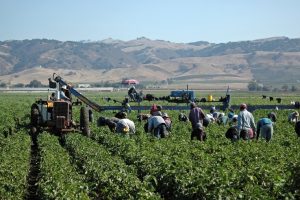22
Mar
Twenty-Eight Senators Urge EPA Administrator to Retain Farmworker Protections
 (Beyond Pesticides, March 22, 2018) Last week Environmental Protection Agency (EPA) Administrator Scott Pruitt received a letter from twenty-eight U.S. Senators urging the preservation of rules that would protect farmworkers and disallow minors to handle highly toxic pesticides. At issue are two proposals from Administrator Scott Pruitt’s EPA that would roll back Agricultural Worker Protection Standards (AWPS) and the Certification of Pesticide Applicators (CPA) rules put in place during the Obama Administration. In their letter, the Senators stress the impact of any potential changes, noting “the lives of children and families across the country at stake.”
(Beyond Pesticides, March 22, 2018) Last week Environmental Protection Agency (EPA) Administrator Scott Pruitt received a letter from twenty-eight U.S. Senators urging the preservation of rules that would protect farmworkers and disallow minors to handle highly toxic pesticides. At issue are two proposals from Administrator Scott Pruitt’s EPA that would roll back Agricultural Worker Protection Standards (AWPS) and the Certification of Pesticide Applicators (CPA) rules put in place during the Obama Administration. In their letter, the Senators stress the impact of any potential changes, noting “the lives of children and families across the country at stake.”
During the Obama era, EPA completed rulemaking that revised AWPS for the first time in over 20 years. Key components expanded training, prohibited children under 18 from applying highly toxic restricted use pesticides, created new no-entry application-exclusion zones, improved record keeping, provided farmworkers a designated representative to request pesticide records, and other safety improvements. The final rules put in place long-overdue protections, but still represented a compromise for workers and farmworker advocates. At the time the rules were released, advocacy organization Farmworker Justice released a statement noting, “While we are disappointed that the final rule does not include some significant safety measures, we will continue to work with our community partners to advocate for greater worker protections at EPA and at the state and local levels.”
After the AWPS rules were updated, then-EPA Administrator Gina McCarthy finalized similar rules under a separate CPA rule, which also improved training requirements for pesticide applicators and prohibited minors from applying restricted use pesticides under most circumstances. Despite the arduous process led to the original compromise, Administrator Pruitt took action in mid-May to delay the implementation of CPA, and was subsequently sued by farmworker and health organizations shortly after.
Now, Administrator Pruitt’s EPA announced its intent to revise segments of both AWPS and CPA, with age requirements, farmworker designated representatives, and no-entry application-exclusion zones under specific scrutiny.
As Huffington Post reports, disclosure records indicate that the American Farm Bureau lobbied EPA to take similar actions. General perception behind the industry’s motivation to reduce the age limit to handle highly toxic pesticides is that minors can be paid less money to apply these chemicals. As the Senators write, “These rules were revised to prevent farmworker poisonings and in the aftermath of pesticide misuse that led to serious harm for hundreds of homeowners and their families, and resulted in the tragic deaths of children.”
Likewise, removing the ability for a farmworker to designate a representative to receive information after he or she was poisoned is presumed to be the agricultural industry’s attempt to limit the ability for farmworkers to sue. “The designated representative provision is critically important because there are many reasons why a worker may be unable to access information about the chemicals they are exposed to,” the Senators write. “This commonsense safeguard has been denied to farmworkers while workers in other industries have had these protections for decades.”
Eliminating the application exclusion zone would do away with important protections that extend out from farm fields to agricultural communities. “The application exclusion zone merely requires the commonsense precaution that if someone is applying pesticides and sees workers or other people around the equipment, they should try to avoid spraying them by suspending the application and resuming after a non-trained and unprotected person leaves the area,” the Senators write in their letter. This is important because EPA does not account for bystander exposure as part of its risk assessment for pesticides, and simply assumes that exposure will not happen.
Congressional pushback is critical in stopping an agenda that has aimed to eliminate farmworker protections, slash EPA staff, and keep highly toxic pesticides with known health risks on the market. Thank you to those that have already asked their Congressmembers to protect AWPS and CPA. Continue to keep the pressure up by sending a letter to your Congressional delegation today.
All unattributed positions and opinions in this piece are those of Beyond Pesticides.
Source: Huffington Post, SCRIBD Senatorial Document










